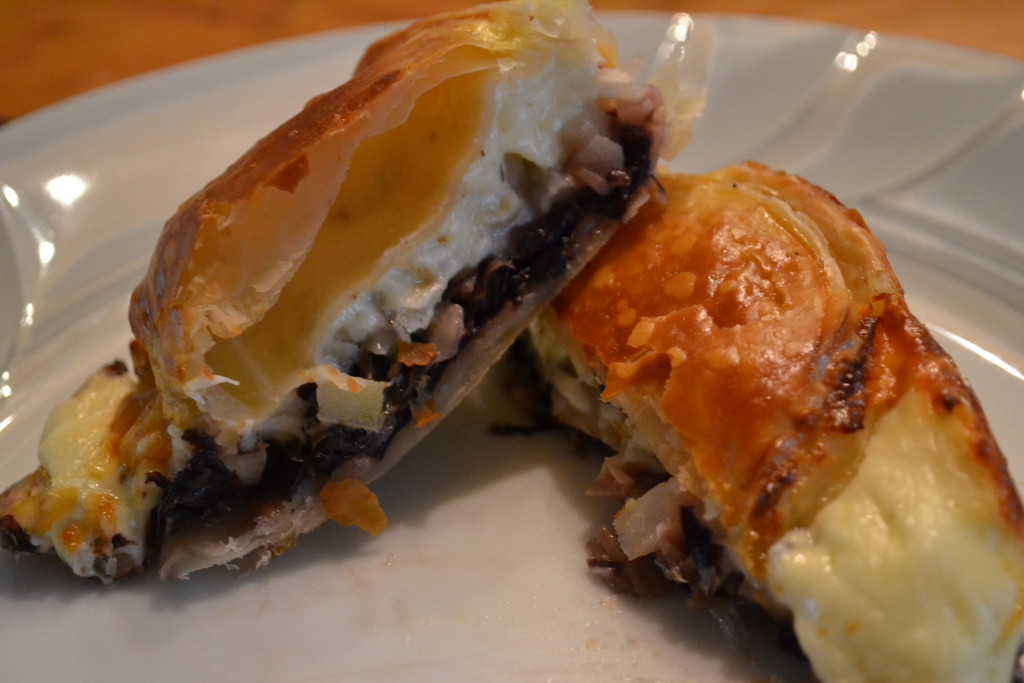On Sunday supplement
Food and Wine
I’ve mentioned before that I often hear people asking about not just what one unusual vegetable or fruit is, but what to do with it. At my little neighborhood verdulería the proprietor takes great pains to call other customers over and ask me to explain what to do with one or another that he’s gotten in stock. Sometimes I think he goes and looks for something different just to see if he can trip me up – thankfully so far I’ve been able to hold my own in the recipe challenges.
‘Tis the season and all that, he’s recently gotten in all sorts of lovely winter vegetables, particularly things like cabbages and endives and the like. One of my favorites of the genre is radicchio, those glowingly beautiful heads of maroon and white leaves. Now, 99% of the time when I see them used in restaurants, they’re simply used in salads, providing a little bitter note and color in contrast to the sweetness and variegated green-ness of various lettuces. While delicious there, that wouldn’t be much of a recipe.
The interesting thing is, that like many other hearty vegetables of similar sort, that bitterness is tamed and changed by cooking – roasting and grilling are particularly good and bringing out the hidden sweet notes and tamping down the bitterness. Radicchio also pairs beautifully with nuts – walnuts and hazelnuts are personal favorites, and also with fruits in the family of pears, apples and quinces.
Let’s take a quick moment to just note what radicchio is – it’s a member of the chicory family – the same family of vegetables whose roots are dried and ground and added to coffee in many parts of the world to soften the bitterness of the brew. Ironic, no? The family includes radicchios (of which there are several types), chicory itself, endives – and not just the “Belgian” endive or witloof that we think of in its torpedo shape of pale green and white, but also frisée and escarole, which are both endives as well. Radicchio’s two most common varieties are the Chioggia – the globe shaped, cabbage like version that most of us are familiar with and which is the only one found here in BA, and the Treviso, which is shaped like a Belgian endive, but decked out in maroon and white colors.
So, on to the cooking, and my version of a favorite dish from the Veneto to tempt you into trying out a head of this little used vegetable….
Fagottini di Radicchio – Radicchio Pies
8 hojaldre (puff pastry) style empanada rounds
1 small head of radicchio (roughly 150 gm)
1 shallot, finely chopped
200 gm cuartirolo cheese
1 pear, diced small (½ cm)
12-15 hazelnuts, toasted and coarsely chopped
1 egg
2 tablespoons milk
1 tablespoon extra virgin olive oil
salt and pepper
Rinse and chop the radicchio, removing the hard core, and saute in a pan with oil, shallots, salt and pepper until the radicchio is just wilted. Remove from heat and let cool.
Empanada rounds are typically about 12 cm. You’ll need four of approximately that diameter. Take another four and cut out rounds using a cookie cutter of about 8 cm. Butter 4 ramekins that are 8 cm in diameter (you can adjust here – if you’ve got slightly smaller or larger ramekins, just adjust the dough diameters to fit) and line with the larger dough rounds, covering the bottom and up the sides. Divide the radicchio between the ramekins and then top with the pear dice and chopped hazelnuts. Divide the cheese in four equal parts and mold into a round and press down over the filling. Classically you’d also add a slice or two of white truffle just under the cheese, if you have a good quality white truffle oil, you could add just a drop or two at the most to the pear and hazelnut mix.
Beat the egg with the milk. Cover the filling with the smaller rounds of dough and press down to pack tightly. Fold in the outer edge of the bottom round and pinch together to seal well. Brush the surface with the egg wash and bake in a 200̊C oven for 15 minutes, until the dough is golden brown and puffed.
Remove from oven and tip each fagottino (“bundle”) out carefully (two oven mitts are a good idea here), brush the sides with more of the egg wash and return to the oven on the same baking sheet to brown the sides well. Serve hot or warm as an amazing little dinner party appetizer.
A series of recipes and articles that I started writing for the Buenos Aires Herald Sunday supplement, Food & Wine section, at the beginning of 2012. My original proposal to them was to take local favorite dishes and classics and lighten them up for modern day sensibilities. We’re not talking spa or diet recipes, but at the very least, making them healthier in content, particularly salt, fat and portion size. As time went by, that morphed into a recipe column that, while emphasizing food that is relatively “good for you”, wasn’t necessarily focused on local cuisine. At the beginning of 2013 I decided to stop writing for them over some administrative issues, but it was fun while it lasted.
